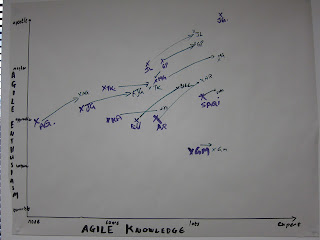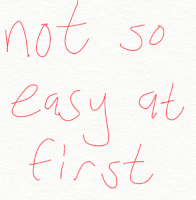Caveats:
The SMART/S.M.A.R.T. acronym has slightly different permutations depending on where and when people learn about it, and where and when they apply it. This is the version I use for the purposes of coaching.
 |
| SMART Actions, Objectives or Goals Make The Difference! |
SMART Goals are extremely powerful change enablement tools for individuals as well as teams. I use them for 1-1 meetings (see my previous post:
My Favourite Coaching Tools: 1-1 Meetings, and Esther Derby and Johanna Rothman's
Behind Closed Doors: Secrets of Great Management
) as well as Retrospectives (see Diana Larsen's
Agile Retrospectives: Making Good Teams Great
). I also use them for individual coaching plans.
Required:
Some past/background information and/or knowledge and a desire to change something in the future.
Paper and pen
Step 1: I write up/down the labels I would like the coachee, or the team I am coaching to apply as:
S - Specific
M - Measurable
A - Achievable
R - Responsible person assigned
T - Timebound
Step 2: Then I give some examples of bad SMART goals and rework them to better/good SMART goals, eg:
"improve our office"
Is not good, because it does not come even close to fitting at least the acronym!
S - improve our office
M - it is tidy
A - we can do this
R - us all
T - end of next month
This is clearer and agreed by the coachee/team that there is significant progress. However I now point out where possible problems could be - and I do this in any order as SMART is not necessarily order-specific!
T - end of next month....?
Is the end of next month a weekend, a Monday or a Friday? Does it make a difference in our collective experience of deadlines? Is the change we're trying to bring about really that hard that it will take so much time to do? What is a more challenging boundary for the time? What prevents you from reaching this goal, and achieving the benefit, today? Tomorrow? And with these kind of questions, even for a hypothetical example, it is clear that a better goal and time boundary is more like which is clearer and "in focus":
T - end of this week
But this too is not really specific enough as there are all sorts of things that can go wrong as ends of weeks have a nasty way of suddenly happening to people and challenging change goals get forgotten in the rush to get away, or get half-done. Is this the morning, noon or afternoon? Or is COB (Close of Business)? Compare to:
T - By 12pm on Friday 8 June 2012.
That's specific! Anyone can now figure out if the goal was achieved definitely by that time, and, importantly the day, date and time is crystal clear and easy to remember/remind about if required which helps to ensure people keep the goal in mind - the sense of urgency automatically increases as the focal point draws nearer.
Now let's look at R... "us all". In team situations, I've found it more effective to actually name a leader for the goal, than allowing a team to loosely assign "team". This leader will execute the Measure and if the goal has not been achieved, encourage the team or provide feedback to the team. The team self-selects the Responsible Person Assigned who uses the opportunity to improve on the craft of servant-leadership.
R - Joe Smith
Now I might flip to S ... "improve our office". What the heck? Does this mean get interior decorators in/architects/cleaners/new furniture/pictures on walls/pictures off walls/bring in a stereo/stop playing heavy metal/etc/etc?
A nice open question helps really get the problem space and possible solution spaces identified: "What of our office should be improved?". For instance "tidiness" might be more specifically phrased as:
S - All our desks to be clear of food, cups, plates, litter, loose papers and dust
Which could be even more improved on by adding if "daily" as opposed to "weekly" is the true intent...to look professional when clients visit.
S - All our desks to be clear of food, cups, plates, litter, paper and dust at the end of every day.
Right so far we have a very clear mental image formed of what needs to happen, by when and who will be checking it. How?
M - "is tidy"
Is subjective! We're looking for 1 objective measure of success that the coachee/team and coach actually agree on (in this case the coach becomes a very cheap additional layer of assurance).
Again, the pause and wait for the coachee/team to come up with objective measures...perhaps
M - There are 0 instances of food, 0 cups, 0 plates, 0 litter, 0 papers and no dust on any desk or table in the entire office by 6pm everyday
Extremely hard to argue that! And even more tricky to achieve if there are empty desks/tables in the office that are used but not "owned" by anyone. How to ensure accountability for "entire office" - which is more the motivation that we discovered along the way - a professional office that clients see when they visit?
These questions/fine tunings are discussed and eventually negotiated ... the Responsible Person Assigned takes notes if this is for a team! :-)
And finally, with such a clear picture in mind for S, M, R and T the final buy-in from the coachee/team is the A. Is this Achievable?
A - Yes, this is achievable!
It is extremely important that the coachee or the team fully buy-in to this goal otherwise motivational energy to do something different is going to be lacking and most times the uplifting goal will not be achieved or it will be achieved but undermined. In which case the session creating the SMART goal is a partial waste of precious time.
And perhaps another 1-2 examples like this, or perhaps into Step 3 - letting the coachee/team attempt for themselves!
Step 3: Now I let the team have their first attempt:
S - improve team culture
M - team is happier
A - we can do this!
R - us all!
T - tomorrow!!
The first time I saw a team copy my poor example it stunned me. Then I realised, especially over time and this copying occurred repeatedly, it's the simplicity and first thing people trying this for the first time do: they take the first step they feel comfortable with, and have seen in the recent past. And know they will be able to improve it with my assistance - as I showed them in the worked examples. And many seem to find it fun to start so obviously wrong!
Anyway, in this example it looks good, and it sounds good - HOORAY! It even fits the acronym slots, so HOORAY x2 for the coachee/team! I sometimes even say encouraging things like "I truly admire your passion and enthusiasm and am encouraged by the rising energy levels.... however, this is not a good SMART goal for the following reasons..." or "I like this start to this goal! And already it is clear based on the worked examples what has to be fixed - so who's first with a suggestion?" Pretty much repeating all that was said in Step 2, in different orders and constantly using the worked examples as reference point.
The main thing is to get everyone collaborating and praising successful steps in unfamiliar territory. Giving people the confidence to try.
For example - I help the coachee or team iterate through their SMART goal attempt and improve it incrementally - this helps get a lot of buy-in from each participant who collaborates and agrees to the exact wording (2 of the jobs of a facilitator is to ensure everyone in the room is heard and is also contributing).
Is "improve team culture" specific?
"Kind of", I might say "...but improve means different things to different team members!". The same for the word "team" as well "culture". At this point I pause......and eventually the coachee or the team start to brainstorm a different way of saying what they want to say. At this time I encourage a bit of divergence of ideas for a while as some of these are relevant for other parts of the acronym if not specifically for Specific. After enough time I encourage convergence by playing back the ideas that have emerged and a better Specific statement at this time might begin to look like:
Team:
We have fun together
We go for lunch together
We go for lunch together to the Fabulous Restaurant that we now all agree on together
Individual:
Produce a high quality weekly team report
Take my weekly report to my manager and discuss what parts are good, and what parts can be improved.
Take my weekly team report to my manager and discuss in detail which parts can be improved and set SMART goals for each of those parts so that I fully understand the required changes and their importance.
After iterating these kinds of statements, very specific pieces of the puzzle are teased out and produce excellent SMART Goals! As the coachee/team become accustomed to the required level of specification, and the forces that are experienced during their creation, they get better and better at this.
Thankyou for supporting! Now go score!
 |
| SMART Goals Objectives Actions As Clear Outcomes Benefit All Striving To Make The Change A Reality |

.JPG)
.JPG)














![Merrill Covey Matrix (By Rorybowman (Own work) [Public domain], via Wikimedia Commons) Covey Matrix](https://upload.wikimedia.org/wikipedia/commons/3/32/MerrillCoveyMatrix.png)





